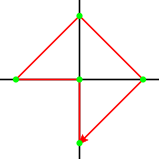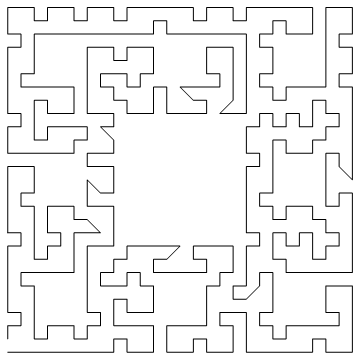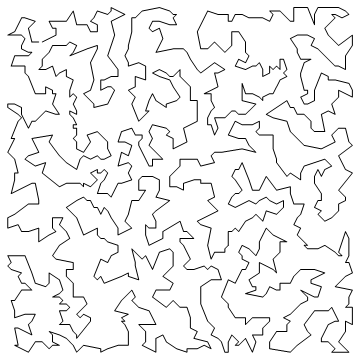22
1
Note: The title of this question should be "Loop It", but because title needs to be at least 15 characters, there are some invisible spaces. This note is such that the challenge can be searched for.
Challenge
Given a finite list of unique integral points in the plane, find a polygon whose vertices are exactly those points, which does not self intersect.
Details
- As input you can take e.g. two lists with each the x- and y-coordinates or a list of pairs.
- The input list contains at least 3 points.
- Note that this means there is never a unique solution.
- The list of inputs is can be assumed to be not co-linear (the points cannot be contained in one line), this means there actually is such a non-self-intersecting polygon.
- The angles at each vertex is arbitrary, this includes 180°.
- For an input of length
n, the output should be a permutation(p1,p2,p3,...,pn)of(1,2,3,...,n)where thek-th entrypkrepresents thep-th point in the input list. This means we have a line fromp1top2, a line fromp2top3etc, as well as a line frompntop1. (You can also use the 0-based indices.) Alternatively you can just output the list of input points in the right order.
Examples
Let's say we have the points [(0,0),(0,1),(1,0),(-1,0),(0,-1)] and we want to represent following path:
This means we would output the list [5,1,4,2,3]
Here some more suggestion to try (I recommend looking at the corresponding plots to verify the goals.)
Triangle
[(0,0),(0,1),(1,0)]
S-Curve
[(0,0),(0,1),(0,2),(0,3),(0,4),(1,0),(2,0),(2,1),(2,2),(2,3),(2,4),(3,4),(4,0),(4,1),(4,2),(4,3),(4,4)]
L-Shape
[(4,0),(1,0),(3,0),(0,0),(2,0),(0,1)]
Menger Sponge
[(1,1),(2,1),(3,1),(4,1),(5,1),(6,1),(7,1),(8,1),(9,1),(10,1),(11,1),(12,1),(13,1),(14,1),(15,1),(16,1),(17,1),(18,1),(19,1),(20,1),(21,1),(22,1),(23,1),(24,1),(25,1),(26,1),(27,1),(1,2),(3,2),(4,2),(6,2),(7,2),(9,2),(10,2),(12,2),(13,2),(15,2),(16,2),(18,2),(19,2),(21,2),(22,2),(24,2),(25,2),(27,2),(1,3),(2,3),(3,3),(4,3),(5,3),(6,3),(7,3),(8,3),(9,3),(10,3),(11,3),(12,3),(13,3),(14,3),(15,3),(16,3),(17,3),(18,3),(19,3),(20,3),(21,3),(22,3),(23,3),(24,3),(25,3),(26,3),(27,3),(1,4),(2,4),(3,4),(7,4),(8,4),(9,4),(10,4),(11,4),(12,4),(16,4),(17,4),(18,4),(19,4),(20,4),(21,4),(25,4),(26,4),(27,4),(1,5),(3,5),(7,5),(9,5),(10,5),(12,5),(16,5),(18,5),(19,5),(21,5),(25,5),(27,5),(1,6),(2,6),(3,6),(7,6),(8,6),(9,6),(10,6),(11,6),(12,6),(16,6),(17,6),(18,6),(19,6),(20,6),(21,6),(25,6),(26,6),(27,6),(1,7),(2,7),(3,7),(4,7),(5,7),(6,7),(7,7),(8,7),(9,7),(10,7),(11,7),(12,7),(13,7),(14,7),(15,7),(16,7),(17,7),(18,7),(19,7),(20,7),(21,7),(22,7),(23,7),(24,7),(25,7),(26,7),(27,7),(1,8),(3,8),(4,8),(6,8),(7,8),(9,8),(10,8),(12,8),(13,8),(15,8),(16,8),(18,8),(19,8),(21,8),(22,8),(24,8),(25,8),(27,8),(1,9),(2,9),(3,9),(4,9),(5,9),(6,9),(7,9),(8,9),(9,9),(10,9),(11,9),(12,9),(13,9),(14,9),(15,9),(16,9),(17,9),(18,9),(19,9),(20,9),(21,9),(22,9),(23,9),(24,9),(25,9),(26,9),(27,9),(1,10),(2,10),(3,10),(4,10),(5,10),(6,10),(7,10),(8,10),(9,10),(19,10),(20,10),(21,10),(22,10),(23,10),(24,10),(25,10),(26,10),(27,10),(1,11),(3,11),(4,11),(6,11),(7,11),(9,11),(19,11),(21,11),(22,11),(24,11),(25,11),(27,11),(1,12),(2,12),(3,12),(4,12),(5,12),(6,12),(7,12),(8,12),(9,12),(19,12),(20,12),(21,12),(22,12),(23,12),(24,12),(25,12),(26,12),(27,12),(1,13),(2,13),(3,13),(7,13),(8,13),(9,13),(19,13),(20,13),(21,13),(25,13),(26,13),(27,13),(1,14),(3,14),(7,14),(9,14),(19,14),(21,14),(25,14),(27,14),(1,15),(2,15),(3,15),(7,15),(8,15),(9,15),(19,15),(20,15),(21,15),(25,15),(26,15),(27,15),(1,16),(2,16),(3,16),(4,16),(5,16),(6,16),(7,16),(8,16),(9,16),(19,16),(20,16),(21,16),(22,16),(23,16),(24,16),(25,16),(26,16),(27,16),(1,17),(3,17),(4,17),(6,17),(7,17),(9,17),(19,17),(21,17),(22,17),(24,17),(25,17),(27,17),(1,18),(2,18),(3,18),(4,18),(5,18),(6,18),(7,18),(8,18),(9,18),(19,18),(20,18),(21,18),(22,18),(23,18),(24,18),(25,18),(26,18),(27,18),(1,19),(2,19),(3,19),(4,19),(5,19),(6,19),(7,19),(8,19),(9,19),(10,19),(11,19),(12,19),(13,19),(14,19),(15,19),(16,19),(17,19),(18,19),(19,19),(20,19),(21,19),(22,19),(23,19),(24,19),(25,19),(26,19),(27,19),(1,20),(3,20),(4,20),(6,20),(7,20),(9,20),(10,20),(12,20),(13,20),(15,20),(16,20),(18,20),(19,20),(21,20),(22,20),(24,20),(25,20),(27,20),(1,21),(2,21),(3,21),(4,21),(5,21),(6,21),(7,21),(8,21),(9,21),(10,21),(11,21),(12,21),(13,21),(14,21),(15,21),(16,21),(17,21),(18,21),(19,21),(20,21),(21,21),(22,21),(23,21),(24,21),(25,21),(26,21),(27,21),(1,22),(2,22),(3,22),(7,22),(8,22),(9,22),(10,22),(11,22),(12,22),(16,22),(17,22),(18,22),(19,22),(20,22),(21,22),(25,22),(26,22),(27,22),(1,23),(3,23),(7,23),(9,23),(10,23),(12,23),(16,23),(18,23),(19,23),(21,23),(25,23),(27,23),(1,24),(2,24),(3,24),(7,24),(8,24),(9,24),(10,24),(11,24),(12,24),(16,24),(17,24),(18,24),(19,24),(20,24),(21,24),(25,24),(26,24),(27,24),(1,25),(2,25),(3,25),(4,25),(5,25),(6,25),(7,25),(8,25),(9,25),(10,25),(11,25),(12,25),(13,25),(14,25),(15,25),(16,25),(17,25),(18,25),(19,25),(20,25),(21,25),(22,25),(23,25),(24,25),(25,25),(26,25),(27,25),(1,26),(3,26),(4,26),(6,26),(7,26),(9,26),(10,26),(12,26),(13,26),(15,26),(16,26),(18,26),(19,26),(21,26),(22,26),(24,26),(25,26),(27,26),(1,27),(2,27),(3,27),(4,27),(5,27),(6,27),(7,27),(8,27),(9,27),(10,27),(11,27),(12,27),(13,27),(14,27),(15,27),(16,27),(17,27),(18,27),(19,27),(20,27),(21,27),(22,27),(23,27),(24,27),(25,27),(26,27),(27,27)]



If we have 4 points O(0,0), A(1,0), B(0,1), C(0,2), is the polygon OABC self-intersecting? – ngn – 2018-01-13T15:25:53.353
@ngn That is a good point I did not consider! I'll have to think about it. If you have any argument for or against this please let me know. – flawr – 2018-01-13T15:50:06.913
@ngn I'd count this polygon as self-intersecting. The reason is that I'd define a polygon to be self intersecting if there is a common point of two edges that is not an endpoint. – flawr – 2018-01-13T15:53:30.763
@flawr I must withdraw my answer then, it fails when there are multiple co-linear points at maximum angle from the reference point. – ngn – 2018-01-13T16:15:31.107